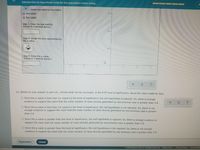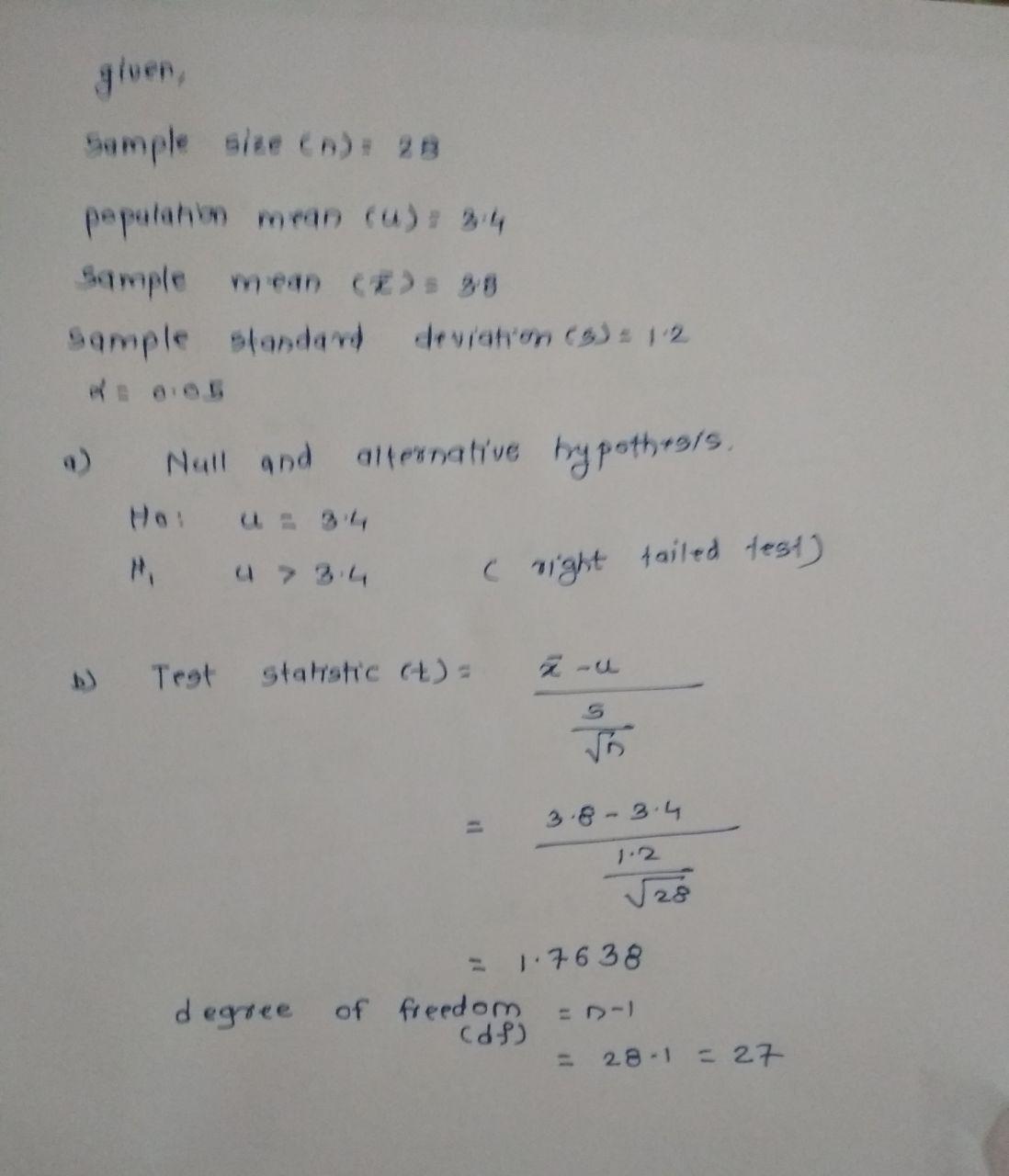
MATLAB: An Introduction with Applications
6th Edition
ISBN: 9781119256830
Author: Amos Gilat
Publisher: John Wiley & Sons Inc
expand_more
expand_more
format_list_bulleted
Question
Still dont understand calculation of p value

Transcribed Image Text:Introduction to hypothesis tests for the population mean using.
Select one-tailed or two-tailed.
O One-tailed
0.3-
O Two-tailed
Step 3: Enter the test statistic,
(Round to 3 decimal places.)
0.2+
Step 4: Shade the area represented by
the p-value,
0.1-
Step 5: Enter the p-value.
(Round to 3 decimal places.)
(c) Based on your answer to part (b), choose what can be concluded, at the 0.05 level of significance, about the claim made by Jane.
O Since the p-value is less than (or equal to) the level of significance, the null hypothesis is rejected. So, there is enough
evidence to support the claim that the mean number of cases directly generated by one previous case is greater than 3.4.
O Since the p-value is less than (or equal to) the level of significance, the null hypothesis is not rejected. So, there is not
enough evidence to support the claim that the mean number of cases directly generated by one previous case is greater
than 3.4.
O Since the p-value is greater than the level of significance, the null hypothesis is rejected. So, there is enough evidence to
support the claim that the mean number of cases directly generated by one previous case is greater than 3,4.
O Since the p-value is greater than the level of significance, the null hypothesis is not rejected. So, there is not enough
evidence to support the claim that the mean number of cases directly generated by one previous case is greater than 3.4.
Explanation
Check
02021 McGraw Hill LLC All Rights Reserved. Terms of Use| Privacy Center Accessibility
![An important measure in the study of contagious infectious diseases is the number of cases directly generated by one previous case. Jane is an epidemiologist
studying the spread of an infectious disease in her country. She claimed that the mean number of cases directly generated by one previous case is now greater
than 3.4. A study of 28 randomly selected cases of the disease is conducted and finds the sample mean number of cases directly generated by one previous
case to be 3.8 with a sample standard deviation of 1.2. Assume that the population of the number of cases directly generated by one previous case is
approximately normally distributed.
Complete the parts below to perform a hypothesis test to see if there is enough evidence, at the 0.05 Jevel of significance, to support the claim that u, the mean
number of cases directly generated by one previous case, is greater than 3.4.
(a) State the null hypothesis H, and the alternative hypothesis H, that you would use for the test.
H: ]
O<O
OSO
O=0
(b) Perform at test and find the p-value.
Here is some information to help you with your t test.
The value of the test statistic is given by t=
• The p-value is the area under the curve to the right of the value of the test statistic.
Student's t Distribution
0.4-
Step 1: Enter the number of degrees
of freedom.
Step 2: Select one-tailed or two-tailed.
Center](https://content.bartleby.com/qna-images/question/53adddb0-ebb2-4e76-a872-01ab126d1a60/9c7156c9-10dd-4805-9d8a-f7636eb5ca87/lb0o7h8_thumbnail.jpeg)
Transcribed Image Text:An important measure in the study of contagious infectious diseases is the number of cases directly generated by one previous case. Jane is an epidemiologist
studying the spread of an infectious disease in her country. She claimed that the mean number of cases directly generated by one previous case is now greater
than 3.4. A study of 28 randomly selected cases of the disease is conducted and finds the sample mean number of cases directly generated by one previous
case to be 3.8 with a sample standard deviation of 1.2. Assume that the population of the number of cases directly generated by one previous case is
approximately normally distributed.
Complete the parts below to perform a hypothesis test to see if there is enough evidence, at the 0.05 Jevel of significance, to support the claim that u, the mean
number of cases directly generated by one previous case, is greater than 3.4.
(a) State the null hypothesis H, and the alternative hypothesis H, that you would use for the test.
H: ]
O<O
OSO
O=0
(b) Perform at test and find the p-value.
Here is some information to help you with your t test.
The value of the test statistic is given by t=
• The p-value is the area under the curve to the right of the value of the test statistic.
Student's t Distribution
0.4-
Step 1: Enter the number of degrees
of freedom.
Step 2: Select one-tailed or two-tailed.
Center
Expert Solution
arrow_forward
Step 1

Step by stepSolved in 3 steps with 4 images

Knowledge Booster
Similar questions
arrow_back_ios
SEE MORE QUESTIONS
arrow_forward_ios
Recommended textbooks for you
 MATLAB: An Introduction with ApplicationsStatisticsISBN:9781119256830Author:Amos GilatPublisher:John Wiley & Sons Inc
MATLAB: An Introduction with ApplicationsStatisticsISBN:9781119256830Author:Amos GilatPublisher:John Wiley & Sons Inc Probability and Statistics for Engineering and th...StatisticsISBN:9781305251809Author:Jay L. DevorePublisher:Cengage Learning
Probability and Statistics for Engineering and th...StatisticsISBN:9781305251809Author:Jay L. DevorePublisher:Cengage Learning Statistics for The Behavioral Sciences (MindTap C...StatisticsISBN:9781305504912Author:Frederick J Gravetter, Larry B. WallnauPublisher:Cengage Learning
Statistics for The Behavioral Sciences (MindTap C...StatisticsISBN:9781305504912Author:Frederick J Gravetter, Larry B. WallnauPublisher:Cengage Learning Elementary Statistics: Picturing the World (7th E...StatisticsISBN:9780134683416Author:Ron Larson, Betsy FarberPublisher:PEARSON
Elementary Statistics: Picturing the World (7th E...StatisticsISBN:9780134683416Author:Ron Larson, Betsy FarberPublisher:PEARSON The Basic Practice of StatisticsStatisticsISBN:9781319042578Author:David S. Moore, William I. Notz, Michael A. FlignerPublisher:W. H. Freeman
The Basic Practice of StatisticsStatisticsISBN:9781319042578Author:David S. Moore, William I. Notz, Michael A. FlignerPublisher:W. H. Freeman Introduction to the Practice of StatisticsStatisticsISBN:9781319013387Author:David S. Moore, George P. McCabe, Bruce A. CraigPublisher:W. H. Freeman
Introduction to the Practice of StatisticsStatisticsISBN:9781319013387Author:David S. Moore, George P. McCabe, Bruce A. CraigPublisher:W. H. Freeman

MATLAB: An Introduction with Applications
Statistics
ISBN:9781119256830
Author:Amos Gilat
Publisher:John Wiley & Sons Inc

Probability and Statistics for Engineering and th...
Statistics
ISBN:9781305251809
Author:Jay L. Devore
Publisher:Cengage Learning

Statistics for The Behavioral Sciences (MindTap C...
Statistics
ISBN:9781305504912
Author:Frederick J Gravetter, Larry B. Wallnau
Publisher:Cengage Learning

Elementary Statistics: Picturing the World (7th E...
Statistics
ISBN:9780134683416
Author:Ron Larson, Betsy Farber
Publisher:PEARSON

The Basic Practice of Statistics
Statistics
ISBN:9781319042578
Author:David S. Moore, William I. Notz, Michael A. Fligner
Publisher:W. H. Freeman

Introduction to the Practice of Statistics
Statistics
ISBN:9781319013387
Author:David S. Moore, George P. McCabe, Bruce A. Craig
Publisher:W. H. Freeman